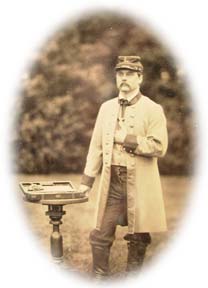The War—Gordonsville Receiving Hospital
On April 17, 1861, Virginia seceded from the Union. On the 17th, the Gordonsville Grays received orders to report to the parade ground. Joined by Companies from Staunton and Charlottesville, they departed on the train from Gordonsville to Harpers Ferry. On April 22, Robert E. Lee arrived at Gordonsville en route to Richmond.
Gordonsville and the railroads which joined there were of immense value to the South during the Civil War. The use of railroads during war were an unknown factor at this time, and the Civil War would later be referred to as the first "railroad war."
In March 1862, the Exchange Hotel, was taken over by military authorities and received the wounded from the battlefields for the duration of the war. It became known as the Gordonsville Receiving Hospital. Dr. B.M Lebby of South Carolina was the director and its operation continued under his leadership until October 1865.
The wounded and dying from nearby battlefields such as Cedar Mountain, Chancellorsville, Trevilian Station, Mine Run, Brandy Station, and the Wilderness were brought by the trainloads. Although this was primarily a Confederate facility, the hospital treated the wounded from both sides. Twenty-six Union soldiers died here.
By war's end more than 70,000 men had been treated at the Gordonsville Receiving Hospital and just over 700 would be buried on its surrounding grounds and later interred at Maplewood Cemetery in Gordonsville.
It is to be remembered, too, when we read of the work of the surgeons and contemplate the mortality figures, that antiseptics were unknown, the relation of dirt to infection was generally not understood, anesthesia was just coming into general use, and drugs were inadequate.
Twice as many men died of disease than of gunshot wounds in the Civil War. Dysentery, measles, small pox, pneumonia, and malaria were the soldier's greatest enemy. The overall poor hygiene in camp, the lack of adequate sanitation facilities, the cold and lack of shelter and suitable clothing, the poor quality of food and water, and the crowded condition of the camps made the typical camp a literal breeding ground for disease.
Contrary to popular myth, most amputees did not experience the surgery without anesthetic. Ample doses of chloroform were administered beforehand.
The Surgeon General instructed the Medical Purveying Depots and Surgeons in the field to gather medicinal plants whose properties may be utilized as substitute medicines. The following recaps several commonly-used plants, and is provided by Jonathan O’Neal, MD Surgeon, PACS, Society of Civil War Surgeons and Civil War Museum Board of Directors Member.
“JUGLANS (Butternut)”
Butternut is a mild cathartic, operating without pain, cramping, or irritation evacuating without debilitating the alimentary canal. It is especially applicable to cases of habitual costiveness and other bowel afflictions, particularly dysentery, in which it has acquired considerable reputation. In combination with calomel, it has sometimes been utilized in the treatment of intermittent and remittent fevers, and the other complaints attended with congestion of the abdominal viscera.
"GLYCYRRHIZA (Liquorice Root)"
Liquorice root is an excellent demulcent that is well adapted to the treatment of catarrhal afflictions, and to irritations of the mucous membranes of the bowels and urinary passages. Liquorice root is best administered in the form of a decoction as described, either alone or combined with other demulcents. It is frequently employed as an addition to the decoctions of acrid or irritating vegetable substances, such as seneka and mezereon, rendering it more acceptable to the stomach .
“DIGITALIS (Foxglove)"
Digitalis is a narcotic, sedative, and diuretic. When administered in quantities sufficient to bring the system decidedly under its influence, it is apt to produce a sense of tightness or weight with dull pain the head, vertigo, dimness or other disorder of vision, and some confusion of thought. It has been regarded as a standard remedy of dropsy since about 1775. It is presently employed very extensively both for its diuretic power and its sedative effects on the heart.

Image of a Civil War Surgeon